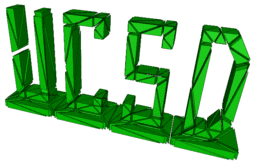| Michael Holst | ||
| https://ccom.ucsd.edu/~mholst/ |
Distinguished Professor of Mathematics and Physics UC San Diego |
|
|
Math 273A (Scientific Computation)
 Course Topics: Computational Mathematics
Course Topics: Computational MathematicsInstructor: Prof. Michael Holst (5739 AP&M, mholst@math.ucsd.edu) Term: Fall 2001 Lecture: 9:05a-9:55a MWF, AP&M 5829 Textbook(s): D. Braess, Finite Elements: Theory, fast solvers, and applications in solid mechanics, 2nd edition, 2001. Class webpage: http://ccom.ucsd.edu/~mholst/teaching/ucsd/273a_f01 CATALOG DESCRIPTION: 273A-B-C. Scientific Computation (4-4-4) Continuum mechanics models of physical and biological systems, finite element methods and approximation theory, complexity of iterative methods for linear and nonlinear equations, continuation methods, adaptive methods, parallel computing, and scientific visualization. Project-oriented; theoretical and software development projects designed around problems of current interest in science and engineering. Prerequisite: experience with Matlab and C, some background in numerical analysis, or consent of instructor. (F,W,S) COURSE INFORMATION: In Math 273A-B-C, we will study the approximation theory foundations of finite element modeling, and we will learn how to build realistic finite element models of physical objects, such as electrostatic and elasticity models of biological molecules and membranes for use in drug design, and elasticity models of clothing and human skin for use in computer animation. The course will be project-oriented and interdisciplinary; we will pick a couple of interesting but hard problems from an application area the first week of class, and then we will spend the rest of the quarter building up the tools (both theoretical and software) to solve the problem, in a provably good way. The catalog description of the course is a little dated; the appropriate preparation for the course is some analysis background (Math 140 or Math 142), some numerical analysis background (Math 170 or 270), and some programming experience (C/C++, MATLAB). HOWEVER, the course will be self-contained in order to allow the participation of graduate students in science and engineering who may not have formal analysis and/or numerical analysis training. There will be flexibility in the design of the individual projects to allow for differences in preparation and interests of the students. LECTURES AND HOMEWORKS: Our time in 273A-B-C will be split up each quarter rougly as follows:
GRADES, EXAMS, DATES: Your grade in the course is based on your project and your 20-minute project presentation during the time of the final.
MCLITE ACCESS: MCLite can be found here. Here is how to use it:
|
